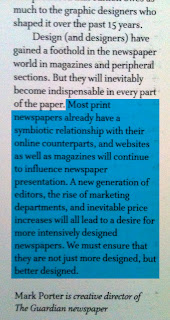This lecture from David Carson is really inspiring. Some quotes I found useful for the research I am doing:
"The End of Print is now in it's fifth printing. When photography was perfected, they said it would be the end of painting, of course it wasn't. "
"Trying to use print as a medium to get people to the web."
David Carson is an American graphic designer. He is best known for his innovative magazine design, and use of experimental typography. He was the art director for the magazine Ray Gun. Carson was perhaps the most influential graphic designer of the 1990s. In particular, his widely imitated aesthetic defined the so-called "grunge typography" era.
In 1989 Carson became art director at the magazine Beach Culture. Although he produced only six issues before the journal folded, his work there earned him more than 150 design awards. By that time, Carson’s work had caught the eye of Marvin Scott Jarrett, publisher of the alternative-music magazine Ray Gun. Ray Gun explored experimental magazine typographic design. The result was a chaotic, abstract style, not always readable, but distinctive in appearance.
The End of Print: The Graphic Design of David Carson, Lewis Blackwell, Lauren King Publishing, 1995, Spain.
These are some covers from Beach Culture & Ray Gun magazines.

I agree with how printed design is more personal in the way that you can feel the texture, weight, size etc. When you view things online it takes away this pleasure.
I definitely agree that technology development is changing how design is being viewed. I think a lot of this is down to social networking. Its so easy to find things and learn from people that inspire you with the likes of twitter and facebook.














































































